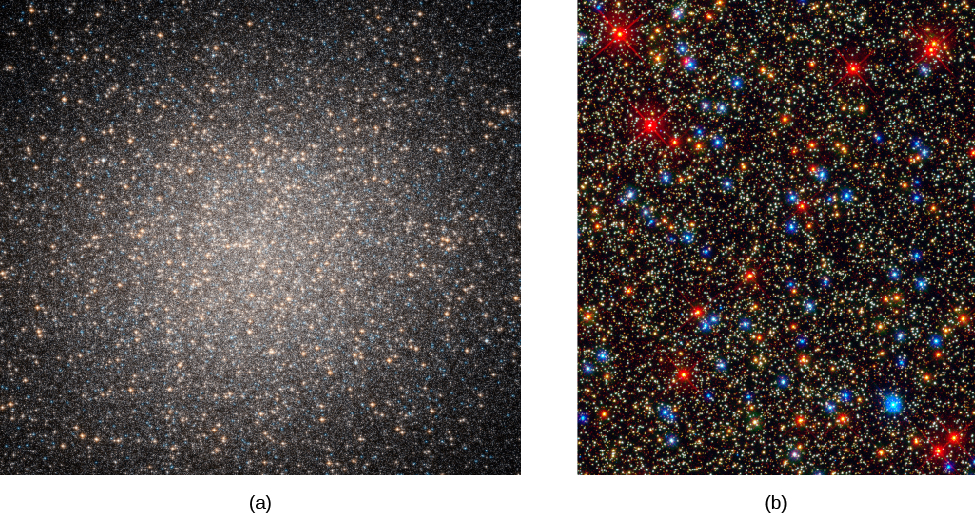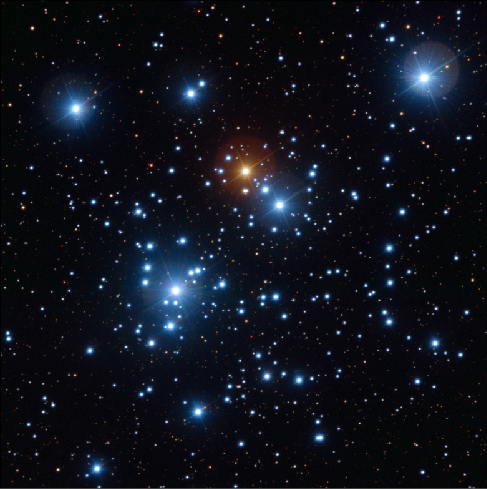Chapter 22 Stars from Adolescence to Old Age
22.2 Star Clusters
Learning Objectives
By the end of this section, you will be able to:
- Explain how star clusters help us understand the stages of stellar evolution
- List the different types of star clusters and describe how they differ in number of stars, structure, and age
- Explain why the chemical composition of globular clusters is different from that of open clusters
The preceding description of stellar evolution is based on calculations. However, no star completes its main-sequence lifetime or its evolution to a red giant quickly enough for us to observe these structural changes as they happen. Fortunately, nature has provided us with an indirect way to test our calculations.
Instead of observing the evolution of a single star, we can look at a group or cluster of stars. We look for a group of stars that is very close together in space, held together by gravity, often moving around a common center. Then it is reasonable to assume that the individual stars in the group all formed at nearly the same time, from the same cloud, and with the same composition. We expect that these stars will differ only in mass. And their masses determine how quickly they go through each stage of their lives.
Since stars with higher masses evolve more quickly, we can find clusters in which massive stars have already completed their main-sequence phase of evolution and become red giants, while stars of lower mass in the same cluster are still on the main sequence, or even—if the cluster is very young—undergoing pre-main-sequence gravitational contraction. We can see many stages of stellar evolution among the members of a single cluster, and we can see whether our models can explain why the H–R diagrams of clusters of different ages look the way they do.
The three basic types of clusters astronomers have discovered are globular clusters, open clusters, and stellar associations. Their properties are summarized in [link]. As we will see in the next section of this chapter, globular clusters contain only very old stars, whereas open clusters and associations contain young stars.
<table id=”fs-id1168047630405″ class=”span-all” summary=”This table contains four columns and nine rows. The first row is a header row and labels each column, unlabeled, “Globular Clusters,” “Open Clusters,” and “Associations.” Under the unlabeled column are the values: “Number in Galaxy,” “Location in Galaxy,” “Diameter (L Y),” “Mass (Solar masses),” “Number of stars,” “Color of brightest stars,” “Luminosity of cluster (LSun),” and “Typical Ages.” Under the “Globular Clusters” column are the values: “150,” “Halo and nuclear bulge,” “50–450,” “104–106,” “104–106,” “Red,” “104–106,” and “Billions of years.” Under the “Open Clusters” column are the values: “Thousands,” “Disk (and spiral arms),” “
Characteristics of Star ClustersCharacteristicGlobular ClustersOpen ClustersAssociationsNumber in the Galaxy150ThousandsThousandsLocation in the GalaxyHalo and central bulgeDisk (and spiral arms)Spiral armsDiameter (in light-years)50–450<30100–500Mass MSun104–106102–103102–103Number of stars104–10650–1000102–104Color of brightest starsRedRed or blueBlueLuminosity of cluster (LSun)104–106102–106104–107Typical agesBillions of yearsA few hundred million years to, in the case of unusually large clusters, more than a billion yearsUp to about 107 years
Globular Clusters
Globular clusters were given this name because they are nearly symmetrical round systems of, typically, hundreds of thousands of stars. The most massive globular cluster in our own Galaxy is Omega Centauri, which is about 16,000 light-years away and contains several million stars ([link]). Note that the brightest stars in this cluster, which are red giants that have already completed the main-sequence phase of their evolution, are red-orange in color. These stars have typical surface temperatures around 4000 K. As we will see, globular clusters are among the oldest parts of our Milky Way Galaxy.

What would it be like to live inside a globular cluster? In the dense central regions, the stars would be roughly a million times closer together than in our own neighborhood. If Earth orbited one of the inner stars in a globular cluster, the nearest stars would be light-months, not light-years, away. They would still appear as points of light, but would be brighter than any of the stars we see in our own sky. The Milky Way would probably be difficult to see through the bright haze of starlight produced by the cluster.
About 150 globular clusters are known in our Galaxy. Most of them are in a spherical halo (or cloud) surrounding the flat disk formed by the majority of our Galaxy’s stars. All the globular clusters are very far from the Sun, and some are found at distances of 60,000 light-years or more from the main disk of the Milky Way. The diameters of globular star clusters range from 50 light-years to more than 450 light-years.

Born and educated in Massachusetts, Helen moved to Victoria, British Columbia in 1931 after marrying Frank Hogg. She began observing stars at the Dominion Astrophysical Observatory Telescope and continued her work at the David Dunlap Observatory when the couple relocated to Toronto in 1935. She soon published her first book, Catalogue of Variable Stars, and started teaching astronomy at the University of Toronto. Helen retired in 1976 as Professor Emeritus and writing her second book, The Stars Belong to Everyone.
Besides her scientific work, Helen helped popularize astronomy in Canada. She wrote a weekly astronomy column for the Toronto Star for thirty years and hosted an astronomy TV show in 1970. She was active in several professional organizations and was the first president of the Astronomical Society of Canada. In addition, Helen was the first female president of Canada’s oldest surviving scientific society; the Royal Canadian Institute.
Helen Hogg received a myriad of awards and distinctions, including being named Companion to the Order of Canada and having an asteroid named after her (2917 Sawyer Hogg). Having passed in 1993, Helen Battles Sawyer Hogg left an influential mark on both astronomy and the public’s perception of the field. She also left numerous articles written for Royal Astronomical Society of Canada which can be found here.
Open Clusters
Open clusters are found in the disk of the Galaxy. They have a range of ages, some as old as, or even older than, our Sun. The youngest open clusters are still associated with the interstellar matter from which they formed. Open clusters are smaller than globular clusters, usually having diameters of less than 30 light-years, and they typically contain only several dozen to several hundreds of stars ([link]). The stars in open clusters usually appear well separated from one another, even in the central regions, which explains why they are called “open.” Our Galaxy contains thousands of open clusters, but we can see only a small fraction of them. Interstellar dust, which is also concentrated in the disk, dims the light of more distant clusters so much that they are undetectable.

Although the individual stars in an open cluster can survive for billions of years, they typically remain together as a cluster for only a few million years, or at most, a few hundred million years. There are several reasons for this. In small open clusters, the average speed of the member stars within the cluster may be higher than the cluster’s escape velocity,1 and the stars will gradually “evaporate” from the cluster. Close encounters of member stars may also increase the velocity of one of the members beyond the escape velocity. Every few hundred million years or so, the cluster may have a close encounter with a giant molecular cloud, and the gravitational force exerted by the cloud may tear the cluster apart.
Several open clusters are visible to the unaided eye. Most famous among them is the Pleiades ([link]), which appears as a tiny group of six stars (some people can see even more than six, and the Pleiades is sometimes called the Seven Sisters). This cluster is arranged like a small dipping spoon and is seen in the constellation of Taurus, the bull. A good pair of binoculars shows dozens of stars in the cluster, and a telescope reveals hundreds. (A car company, Subaru, takes its name from the Japanese term for this cluster; you can see the star group on the Subaru logo.)
The Hyades is another famous open cluster in Taurus. To the naked eye, it appears as a V-shaped group of faint stars marking the face of the bull. Telescopes show that Hyades actually contains more than 200 stars.
Stellar Associations
An association is a group of extremely young stars, typically containing 5 to 50 hot, bright O and B stars scattered over a region of space some 100–500 light-years in diameter. As an example, most of the stars in the constellation Orion form one of the nearest stellar associations. Associations also contain hundreds to thousands of low-mass stars, but these are much fainter and less conspicuous. The presence of really hot, luminous stars indicates that star formation in the association has occurred in the last million years or so. Since O stars go through their entire lives in only about a million years, they would not still be around unless star formation has occurred recently. It is therefore not surprising that associations are found in regions rich in the gas and dust required to form new stars. It’s like a brand new building still surrounded by some of the construction materials used to build it and with the landscape still showing signs of construction. On the other hand, because associations, like ordinary open clusters, lie in regions occupied by dusty interstellar matter, many are hidden from our view.
Key Concepts and Summary
Star clusters provide one of the best tests of our calculations of what happens as stars age. The stars in a given cluster were formed at about the same time and have the same composition, so they differ mainly in mass, and thus, in their life stage. There are three types of star clusters: globular, open, and associations. Globular clusters have diameters of 50–450 light-years, contain hundreds of thousands of stars, and are distributed in a halo around the Galaxy. Open clusters typically contain hundreds of stars, are located in the plane of the Galaxy, and have diameters less than 30 light-years. Associations are found in regions of gas and dust and contain extremely young stars.
Footnotes
- 1 Escape velocity is the speed needed to overcome the gravity of some object or group of objects. The rockets we send up from Earth, for example, must travel faster than the escape velocity of our planet to be able to get to other worlds.
Glossary
- association
- a loose group of young stars whose spectral types, motions, and positions in the sky indicate a common origin
- globular cluster
- one of about 150 large, spherical star clusters (each with hundreds of thousands of stars) that form a system of clusters in the center of our Galaxy
- open cluster
- a comparatively loose cluster of stars, containing from a few dozen to a few thousand members, located in the spiral arms or disk of our Galaxy; sometimes referred to as a galactic cluster

